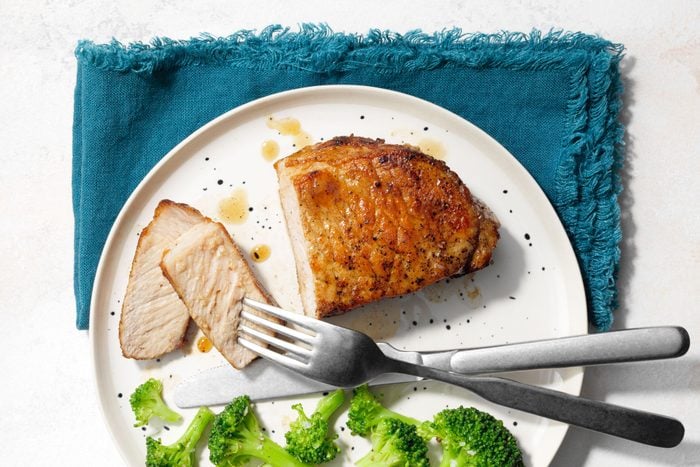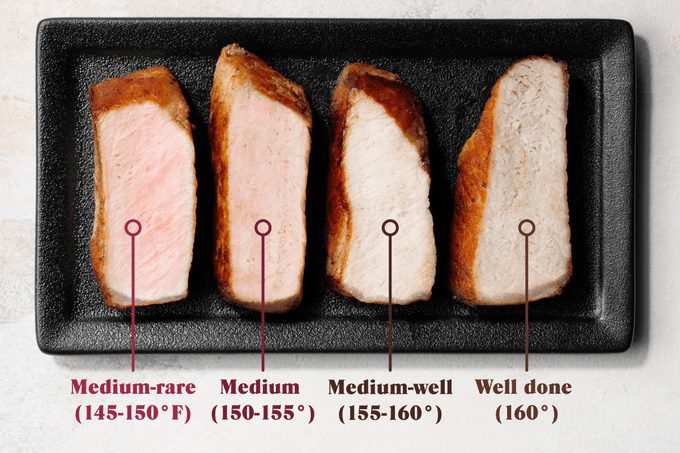What Is the Right Internal Temperature for Pork Chops?
Updated: Jul. 31, 2023

It's time to brush up on proper pork cooking temperature. Hit the right number on your meat thermometer to make all the difference in taste and texture.
Never in the history of cooking proteins has there been more debate about the correct temperature than with pork. Sure, people have strong preferences about the doneness of bacon, but somehow the ideal pork chop temp became a hot topic. It may have something to do with the history of pig farming and food safety.
“In the past, when pigs were often fed food scraps, there was a concern about the pigs becoming infected with parasites,” says James Murray, a professional chef that works for the National Pork Board. “To minimize that risk, chops and other muscle cuts got overcooked to the point they were dry and flavorless. The industry has made many changes regarding housing and pig diets, so the risk of parasites in pork you buy at the grocery store has dropped significantly.”
Because so many people are used to overcooked, dry pork, they don’t buy it as often as they would if it was juicy and tender. Thankfully, it’s an easy fix (just be sure to thaw pork chops safely before cooking).
How to Check the Internal Temperature of Pork
“There’s no substitute for a good digital meat thermometer, which can give you an exact internal temperature so there’s no guesswork involved,” says chef Matt Moore, author of Butcher on the Block.
Many models are quite inexpensive, but if you want to get fancy, upgrade to one that pairs with a phone app via Bluetooth that will create alerts to tell you when your meat is ready.
When it comes to checking the internal temperature of meat, Moore says to take the temperature from a few places: an inch away from any bone (temps directly taken from the meat adjacent to bone will typically be a bit lower due to the heat transfer), and in the center, or thickest part. This will take some practice.
“Ultimately, taking temperatures throughout the process is a good rule of thumb until you become more comfortable with temperature control,” says Moore.
Follow the thermometer manufacturer’s instructions for when to test. Murray notes that some probes are only meant to be used toward the end of the cook, whereas a number of probes used for barbecuing or oven roasting can be inserted in the cut before the cook.
Internal Temperatures for Pork Chops

So what’s the safe pork chop temp? “The USDA determined that any parasites that could contaminate pork die at 138°F internal temperature,” says Murray. “This is why whole muscle cuts of pork like roasts and chops are safe, juicy and flavorful at 145° internal temperature with a proper resting period.”
If a medium-rare 145-150° isn’t desirable, then try additional temperatures from the National Pork Board: medium (150-155°), medium-well (155-160°) or well done (160°).
But seriously, give the 145° pork chop a shot. “A chop cooked to that temperature is just a different eating experience,” says Murray. “It’s juicier, more flavorful and certainly more tender. There’s nothing better than a pork chop or roast that’s rosy pink in the middle when you cut into it!”
How to Serve Pork Chops
While you might be eager to dig right into your freshly cooked pork chops, force yourself to wait a few minutes. “Definitely rest them for at least three minutes,” says Murray. “That time allows the juices to re-distribute themselves more evenly throughout the muscle. Give the chop a moment to collect itself, and it will deliver the maximum flavor profile and juiciness.”
Beyond that, have fun with your newfound love of pork. “Pork is a pretty blank canvas—and it’s affordable,” says Moore. “A pork tenderloin is often an elegant option to serve to host an affordable dinner party, and it takes well to brining, marinade or a sauce or salsa to serve.”
Internal Temperatures for Other Cuts of Pork
The USDA guidelines below are safe temperatures to cook pork, but Murray says they are not necessarily the ideal temperatures for tenderness, flavor and/or texture. “For example, if you’re cooking or smoking a pork shoulder for pulled pork, you’ll want an internal temperature between 200° and 205°. The meat is safe to eat at 145°, but it’s impossible to tear the muscle apart at that temp!” Here’s what to look, for no matter which cut of pork you’re cooking:
| Beef, pork, veal and lamb steaks, chops, roasts | 145°F (62.8°C) and allow to rest for at least 3 minutes |
| Ground meats, including pork | 160°F (71.1°C) |
| Ham, fresh or smoked (uncooked) | 145°F (62.8°C) and allow to rest for at least 3 minutes |
| Fully cooked ham (to reheat) | Reheat cooked hams packaged in USDA-inspected plants to 140°F (60°C) and all others to 165°F (73.9°C). |
